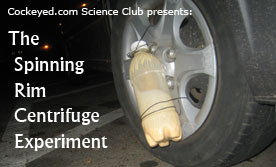

 |
|
 |
|
On Tuesday, I used my car's spinning rim as a centrifuge. |
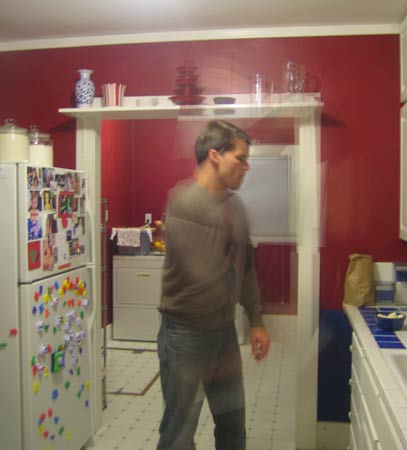 A centrifuge is a device which spins around, subjecting whatever is inside to a strong force. This force can be used to separate the heavy parts of a mixture from the lighter parts. For example, if you spin a nearly-empty bottle of chocolate sauce around, you can force the remaining chocolate sauce towards the opening. A centrifuge is a device which spins around, subjecting whatever is inside to a strong force. This force can be used to separate the heavy parts of a mixture from the lighter parts. For example, if you spin a nearly-empty bottle of chocolate sauce around, you can force the remaining chocolate sauce towards the opening.I've also used a centrifuge at a Laundromat overseas. For just 25p, my wet clothes were spun at an incredible speed, whipping water out of them. This was much cheaper and energy efficient than heating the clothes and removing the water through evaporation. Though, it did seem a little dangerous. |

|
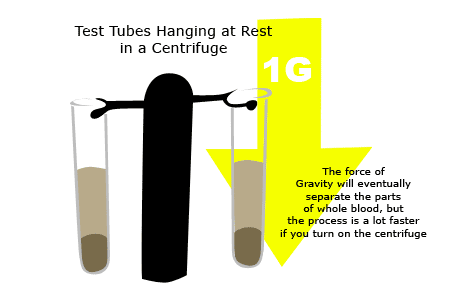 Centrifuges are also used to separate cream from whole milk. Given time, the cream will rise to the top. If you use a centrifuge, you can separate the two in just a few minutes. Centrifuges are also used to separate cream from whole milk. Given time, the cream will rise to the top. If you use a centrifuge, you can separate the two in just a few minutes.Centrifuges are commonly used in biology to separate parts of whole blood. |
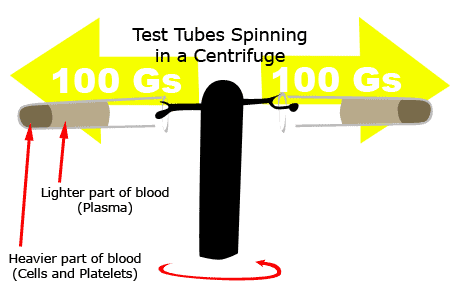 The spinning action forces blood cells and platelets to the bottom of the container, while clear plasma is left at the top. (It is easier to perform chemical tests using just the plasma). The spinning action forces blood cells and platelets to the bottom of the container, while clear plasma is left at the top. (It is easier to perform chemical tests using just the plasma).
|
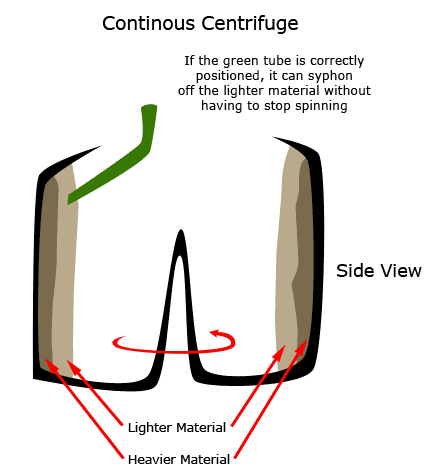 For industrial applications, a continuous centrifuge is sometimes used. A continuous centrifuge works by pouring liquid onto a stack of spinning bowls. The bowls are arranged almost like a Christmas tree, spinning on its trunk. The liquid which is to be separated (feedstock) is poured down the center, where it falls onto the plates. The heavier material (precipitate) tends to fly away from the lighter part of the fluid (supernatant), falling against the sides of a bowl and splatting against the inside walls of the centrifuge. The lighter material ends up pressed against the sides too, but the heavy material is always closest to the actual walls. For industrial applications, a continuous centrifuge is sometimes used. A continuous centrifuge works by pouring liquid onto a stack of spinning bowls. The bowls are arranged almost like a Christmas tree, spinning on its trunk. The liquid which is to be separated (feedstock) is poured down the center, where it falls onto the plates. The heavier material (precipitate) tends to fly away from the lighter part of the fluid (supernatant), falling against the sides of a bowl and splatting against the inside walls of the centrifuge. The lighter material ends up pressed against the sides too, but the heavy material is always closest to the actual walls.The mechanism for a salad spinner or laundry centrifuge is a little different. The cylinder which contains the clothes or lettuce is perforated, allowing liquid to be flung completely out of the spinning cylinder, away from the clothes or lettuce. |
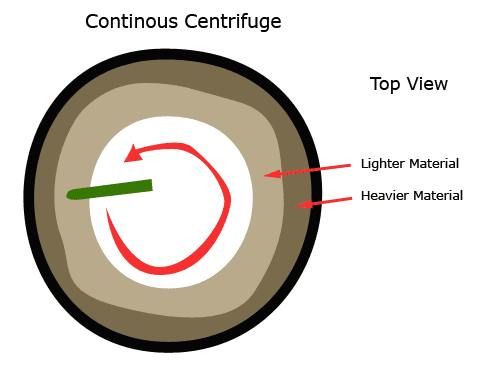
|
 Centrifuges can also be used to separate mixed gasses. This can be hard to envision, but just as heavier gasses drift to the ground in the atmosphere, heavier gasses get pulled to the outside of the can in a centrifuge. For example, if you put a helium/nitrogen mix into a centrifuge, the heavy nitrogen would be thrown flush against the outside walls. The helium would also be thrown toward the walls, but it would lie against the layer of nitrogen there. Centrifuges can also be used to separate mixed gasses. This can be hard to envision, but just as heavier gasses drift to the ground in the atmosphere, heavier gasses get pulled to the outside of the can in a centrifuge. For example, if you put a helium/nitrogen mix into a centrifuge, the heavy nitrogen would be thrown flush against the outside walls. The helium would also be thrown toward the walls, but it would lie against the layer of nitrogen there.Gas centrifuges are always in the news because they are used to separate the valuable, dangerous, volatile isotopes of Uranium 235 from natural Uranium, which is mostly comprised of lowly Uranium 238. Building gas centrifuges that can actually separate the two varieties is really tough, because the two isotopes are almost exactly the same weight (And they are expensive, caustic and radioactive, not to mention Mohammad el Baradei will be all over your ass if he hears about your plans). |
| Yes, centrifuges are exciting. They are used in kitchens, laundromats, hospitals, carnivals, laboratories, sugar factories and weapons facilities, and soon there would be one on the front of my car. |
|
|
Please continue reading page two of the Spinning Rim Centrifuge
cockeyed science club | cockeyed home | Contact Rob | Red Hot Vioxx Action! | Tanning | Making a Candle Out of Lipstick | Evaporation | The lift of a Helium Balloon | Lard Candle | The Properties of Heat Transfer | Insulation Testing | Eating Out | Eating In | Tattoo Removal | Viscosity Testing
March 28th, 2007